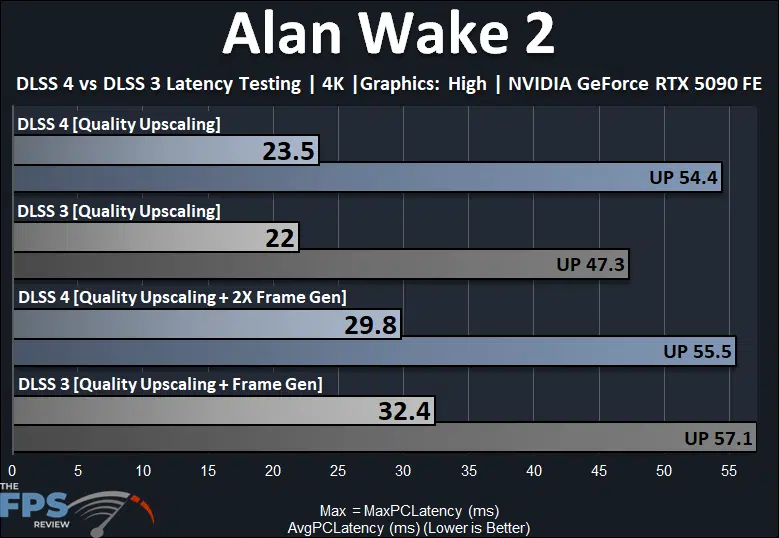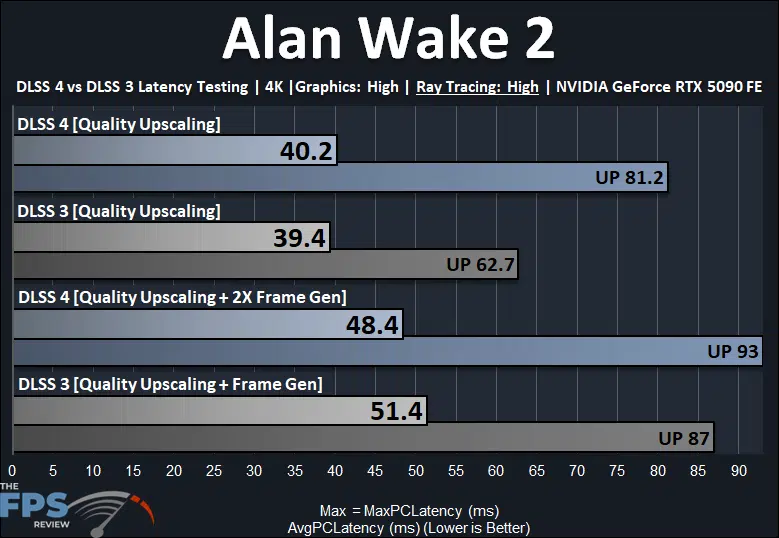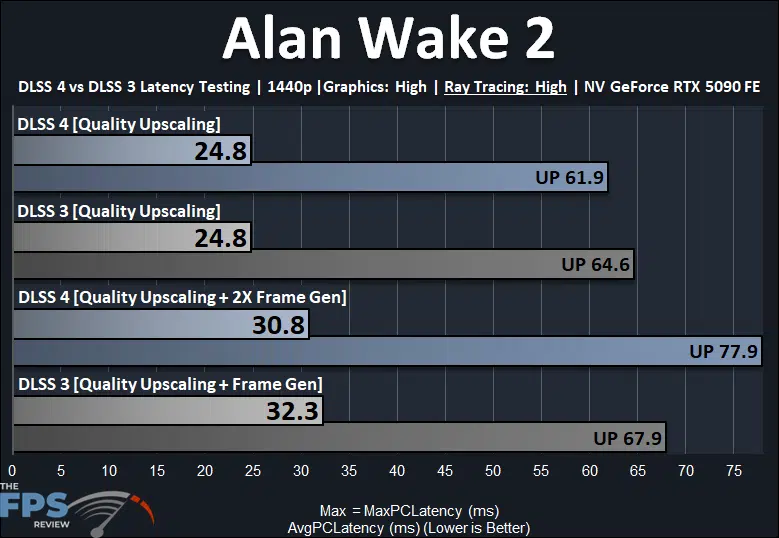Gameplay Performance – DLSS 3 vs DLSS 4 Latency
*Take Note* – The performance shown below is not FPS, it is in fact PC Latency represented in milliseconds. We utilized NVIDIA FrameView to capture statistics while playing these games, and are showing the AvgPCLatency and MaxPCLatency results as indicated by NVIDIA FrameView data. For Latency, the lower the number, the better. Therefore, we are showing the MaxPCLatency which shows the highest latency number achieved in the run-through, which would be a “bad” result, you really want the Max Latency to be as low as it can be for the best experience while gaming.
In a similar vein to what we did above, we are also looking at PC Latency below, but now we are going to directly compare DLSS 3’s latency to DLSS 4’s latency on the NVIDIA GeForce RTX 5090 FE video card. In Alan Wake 2, we have the ability to show two versions of the game, in one version only DLSS 3 is supported, and so we have tested that on the GeForce RTX 5090, and then in a beta dev version NVIDIA gave us access to, we can also test DLSS 4 on the GeForce RTX 5090. In this way, we can directly compare DLSS 4 Upscaling between DLSS 3 and DLSS 4, as well as Frame Generation between DLSS 3 and DLSS 4.
Alan Wake 2 – 4K

In Alan Wake 2, we are running at 4K with “High” preset on the NVIDIA GeForce RTX 5090 FE. We are directly comparing DLSS 3 Upscaling versus DLSS 4 Upscaling, as well as DLSS 3 Frame Generation versus DLSS 4 2x Frame Generation. The numbers on the graph are latency, in milliseconds, lower is better. Right off the bat, it seems DLSS 4 Upscaling has an increased latency over DLSS 3 Upscaling in this title. We see the average latency and especially the max latency, increase with DLSS 4 versus DLSS 3 on the Upscaling component. The average isn’t too far off, but it’s the max latency that will effect the experience the most.
When we look at Frame Generation, we find that there is actually a decrease in latency with DLSS 4 Frame Generation on the average and the max. Therefore, it seems latency is a bit lower with DLSS 4 2x Frame Gen versus DLSS 3 Frame Gen on the RTX 5090, which is positive. It’s just very interesting that the DLSS Upscaler part has an increased latency, perhaps the new Transformer Model causes a bit more latency than the CNN model?
Alan Wake 2 – 4K RT

In the graph above, we are now running Alan Wake 2 at 4K with “High” Ray Tracing enabled, this really tests the RTX 5090 because the framerates are much lower here. When we enable DLSS 4 Upscaling we once again see a pretty big increase in latency over DLSS 3 Upscaling. This is quite a bit exaggerated with the maximum latency here at 81ms with DLSS 4 Upscaling versus 62ms with DLSS 3 Upscaling. Once again, perhaps the Transformer Model has more latency than the CNN model?
When we look at Frame Generation, it is quite interesting, DLSS 4 Frame Generation has a lower average than DLSS 3 Frame Generation, but a much higher maximum. That is different than what we experienced without Ray Tracing, but here, it seems the new DLSS 4 Frame Generation causes a slightly higher maximum latency when the framerates are low.
Alan Wake 2 – 1440p RT

Just to be thorough, we also tested 1440p with “High” Ray Tracing enabled on the NVIDIA GeForce RTX 5090 FE. At this lower resolution, now the DLSS 4 Upscaling and DLSS 3 Upscaling latency is pretty much the same, so there seems to be no difference at this lower resolution. However, we see once again that with Ray Tracing enabled the Frame Generation is slightly higher with DLSS 4 Frame Generation over DLSS 3 Frame Generation. The average is slightly lower, but the maximum latency increases quite a bit, oddly.
